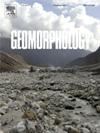Geomorphodiversity and anthropization indices for Italian urban areas
IF 3.1
2区 地球科学
Q2 GEOGRAPHY, PHYSICAL
引用次数: 0
Abstract
Urban geomorphology analyzes modifications of morphology and topography induced by human activity in cities, urban and peri–urban areas. Urban expansion modifies ecosystems, but global actions for sustainability focus on the biosphere, overlooking the role of abiotic components, embedded in and supported by the geosphere and its ecosystem services.
We propose the joint study of indicators of land surface variability and of anthropic modifications. We consider geomorphodiversity, as a discrete measure of richness and variability of abiotic components, and a new index describing the degree of human impact inferred from land cover classes. We suggest that a joint study of the two indicators helps quantifying and understanding the effect of specific land cover changes on areas with different values of geomorphodiversity and the relationships between abiotic parameters and the human presence in urban areas.
Public datasets permits study geomorphology simultaneously at the national scale, and the local scale, within individual urban areas. We show that (1) urban development in Italy was fostered in lowlands, alluvial plains or hills, and urban areas with large values of geomorphodiversity host larger numbers of natural areas; (2) different definitions of urban boundaries are essential to investigate different aspects of human impact on the landscape; (3) synthetic scenarios of land use change, corresponding to different values of anthropization, are useful to study the effect on geomorphodiversity.
Quantitative geomorphodiversity and anthropization index contain complementary information, and their joint study is an additional tool to plan city development and conservation of natural areas in a broad sense.
求助全文
约1分钟内获得全文
求助全文
来源期刊

Geomorphology
地学-地球科学综合
CiteScore
8.00
自引率
10.30%
发文量
309
审稿时长
3.4 months
期刊介绍:
Our journal''s scope includes geomorphic themes of: tectonics and regional structure; glacial processes and landforms; fluvial sequences, Quaternary environmental change and dating; fluvial processes and landforms; mass movement, slopes and periglacial processes; hillslopes and soil erosion; weathering, karst and soils; aeolian processes and landforms, coastal dunes and arid environments; coastal and marine processes, estuaries and lakes; modelling, theoretical and quantitative geomorphology; DEM, GIS and remote sensing methods and applications; hazards, applied and planetary geomorphology; and volcanics.
 求助内容:
求助内容: 应助结果提醒方式:
应助结果提醒方式:


